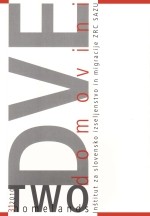The European Union – A New Homeland for Illegal Immigrants? A Study of Imaginaries of the European Union
Keywords:
European Union, representation, illegal immigrants, media, in-depth interviewsAbstract
Several studies deal with representation of the European Union (EU), but none of them analyzes the views of the contemporary Others of the EU. This study tries to fill this gap and to expand the post-nationalist approach to studying the EU with data gained from indepth interviews with illegal immigrants from Africa. The results show that before leaving Africa, illegal immigrants associated the EU with economic success based on the media, members of organized crime groups, and false images of immigrant life in the EU. On the basis of their experiences, their image of the EU changed: Europe is a land of repression, modern slavery, and racism.
Downloads
References
Accardi, Andrea (2009). Hundreds of Sudanese Refugees Living in Abandoned Train Station in Rome, http://doctorswithoutborders.org/news/article.cfm?id=942%20 &cat=field-news (24. 12. 2009).
Amin, Ash (2004). Multi-Ethnicity and the Idea of Europe. Theory, Culture & Society, 21(2): 1–24.
Antonsich, Marco (2008). The Narration of Europe in “National” and “Post-national” Terms. European Journal of Social Theory, 11(4): 505–522.
Bales, Kevin, Trodd, Zoe, and Kent Williamson, Alex (2009). Modern Slavery. Oxford: Oneworld.
Balibar, Etienne (2004). We the People of Europe. Princeton: Princeton University Press.
Banjac, Marinko (2009). (Ne)zaželeni sosed. Časopis za kritiko znanosti, 37(1): 90–101
Bauman, Zygmunt (2004). Europe: An Unfinished Adventure. Cambridge: Polity.
Beck, Ulrich (2003). Toward a New Critical Theory with a Cosmopolitan Intent. Constellations, 10(4): 453–468.
Beck, Ulrich and Grande, Edgar (2007). Cosmopolitanism. European Journal of Social Theory, 10(1): 67–85.
Bialasiewicz, Luiza (2009). Europe as/at the border. Social & Cultural Geography, 10(3): 319–336.
Brady, Hugo (2009). EU migration policy. London: Centre for European Reform.
Carrera, Sergio and Merlino, Massimo (2009). Undocumented Immigrants and Rights in the EU. Brussels: Centre for European Policy Studies.
Colombino, Annalisa (2009). Multiculturalism and time in Trieste. Social & Cultural Geography, 10(3): 279–297.
Cram, Laura (2001). Imagining the Union. Interlocking Dimensions of European Integration (Ed. Helen Wallace). London: Palgrave, 343–362.
De Haas, Hein (2008). The Myth of Invasion: the inconvenient realities of African migration to Europe. Third World Quarterly, 29(7): 1305–1322.
Della Porta, D. (2003). Forms of Europeanisation of the Public Sphere and How to Explain Them, http://europub.wz-berlin.de (24. 12. 2009).
Diken, Bülent (2004). From Refugees to Gated Communities. Citizenship studies, 8(1): 83–106.
Etzioni, Amitai (2007). The Community Deficit. Journal of Common Market Studies, 45(1): 23–42.
European Union Agency for Fundamental Rights (2009). European Union Minorities and Discrimination Survey Report, http://fra.europa.eu/fraWebsite/attachments/ eumidis_mainreport_conference-edition_en_.pdf (24. 12. 2009).
Finotelelli, Claudia and Sciortino, Guiseppe (2009). Importance of Being Southern. European Journal of Migration and Law, 11(2): 119–138.
Frontex (2009). The impact of the global economic crisis on illegal migration to the EU. Warsaw, August 2009, http://www.frontex.europa.eu/gfx/frontex/files/justyna/frontex_raport.pdf (24. 12. 2009).
Habermas, Jürgen (1998). The Inclusion of the Other. Cambridge, MA: MIT Press.
Hansen, Andreas, Cottle, Simon, Negrine, Ralph, and Newbold, Chris (1998). Mass Communication Research Methods. London: MacMillan press.
Huysmans, Jeff (2006). The European Union and the Securitization of Migration. Journal of Common Market Studies, 38(5): 751–777.
Kritzinger, Sylvia (2005). European Identity Building from the Perspective of Efficiency. Comparative European Politics, 10(3): 50–75.
Licata, Laurent, Klein, Olivier, Casini, Annalisa, Coscenza, Alessandra, and Azzi, Assaad E. (2003). Driving European Identification through Discourse. Psychologica Belgica, 43(1–2): 85–102.
Machill, Marcel, Beiler, Markus, and Fischer, Corinna (2006). Europe-Topics in Europe’s Media. European Journal of Communication, 21(1): 57–88.
Mann, Michael (1998). Is There a Society Called Euro? Globalization and Europe: Theoretical and Empirical Investigations (Ed. Roland Axtmann). London: Pinter, 184–207.
Mastnak, Tomaž (Ed.) (2001). Obrazi naše Evrope. Ljubljana: Mirovni inštitut.
Milohnić, Aldo (2001) (Ed.). Evropski vratarji. Ljubljana: Mirovni inštitut.
Minca, Claudio (2009). “Trieste Nazione” and its geographies of absence. Social & Cultural Geography, 10(3): 257–277.
Morley, David and Robins, Kevin (1995). Spaces of Identity. London: Routledge.
Neumann, Iver B. and Welsch, Jennifer M. (1991). The Other in European self-Definition. Review of International Studies, 17(4): 327–348.
Nicolaïdis, Kalypso and Howse, Robert (2002). “This is my EUtopia …”: Narrative as Power. Journal of Common Market Studies, 40(4): 767–92.
Pushed Back, Pushed Around (2009). New York: Human Rights Watch's report.
Šabec, Ksenija (2006). Homo europeus. Ljubljana: FDV.
Shore, Chris (2000). Building Europe. London: Routledge.
Smith, Anthony D. (1992). National Identity and the Idea of European Unity. International Affairs, 68(1): 55–76.
Soysal, Yasemin Nuhoglu (2002). Locating Europe. European Societies, 4(3): 265–84.
Stråth, Bo (2002). A European Identity. European Journal of Social Theory, 5(4): 387–401.
Trenz, Hans-Jörg (2002). Zur Konstitution politischer öffentlichkeit in der Europäischen Union. Baden-Baden: Nomos.
Velikonja, Mitja (2005). Evroza. Ljubljana: Mirovni inštitut.
Waley, Paul (2009). Introducing Trieste: a cosmopolitan city? Social & Cultural Geography, 10(3): 243–256.
Zavratnik Zimic, Simon (2001). Perspektiva konstruiranja schengenske “e-meje”: Slovenija. Evropski vratarji (Ed. Aldo Malohnić). Ljubljana: Mirovni inštitut, 67–82.
Downloads
Published
How to Cite
Issue
Section
License

This work is licensed under a Creative Commons Attribution-NonCommercial-NoDerivatives 4.0 International License.
Authors guarantee that the work is their own original creation and does not infringe any statutory or common-law copyright or any proprietary right of any third party. In case of claims by third parties, authors commit their self to defend the interests of the publisher, and shall cover any potential costs.
More in: Submission chapter





